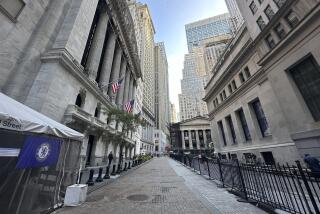Comments by Greenspan Have a Calming Effect
- Share via
Stock and bond markets calmed Wednesday after Federal Reserve Chairman Alan Greenspan appeared to signal that the central bank wasn’t in a hurry to raise interest rates.
Or at least, that’s how investors decided to read his latest comments -- even though stock and bond prices had fallen sharply on Tuesday after Greenspan said much the same things about the economy and the inflation outlook.
The Fed chief, testifying Wednesday before the congressional Joint Economic Committee, described the economy as “vigorous” and said the central bank’s benchmark short-term rate of 1% “must rise at some point” to keep inflation in check.
But he said that, “As yet, the protracted period of monetary accommodation has not fostered an environment in which broad-based inflation pressures appear to be building,”
Markets had tumbled on Tuesday after Greenspan told the Senate Banking Committee that the risk of deflation -- a broad and sustained decline in prices -- has evaporated, and that the nation’s banking industry was well-prepared to handle higher interest rates.
Some investors took those comments to be a warning that the Fed would soon tighten credit to match the healthier economic outlook. The Fed’s key rate, at 1%, is at a 46-year low.
The Dow Jones industrial average dropped 123.35 points, or 1.2%, to 10,314.50 on Tuesday.
On Wednesday, however, the Dow rebounded from a loss of 64 points early in the session to close up 2.77 points, at 10,317.27.
The Nasdaq composite rose 17 points, or 0.9%, to 1,995.63 after diving 2.1% on Tuesday.
The yield on the 10-year Treasury note, a benchmark for other long-term rates, ended at 4.42%, down from the six-month high of 4.46% reached on Tuesday.
Many economists said Greenspan and other Fed officials have offered up a mostly uniform message in recent weeks: that the nation should be preparing for higher interest rates.
But the lack of urgency in the message indicates that the Fed doesn’t want Wall Street to think a rate increase will happen at the central bank’s May 4 meeting, and perhaps not even at the following meeting, set for June 30, analysts said.
“By giving plenty of notice, everyone can get prepared,” said Allen Sinai, head of Decision Economics Inc. in New York.
“They’re doing everything they can to signal a gradual unwinding” of generational-low interest rates, said Amy Falls, a bond market strategist at Morgan Stanley in New York.
In his testimony, Greenspan was upbeat on the economy and cited rising corporate optimism.
“Importantly, the caution among business executives that had previously led them to limit their capital expenditures appears to be giving way to a growing confidence in the durability of the expansion,” he said.
He also reiterated that the Fed wasn’t worried about inflation accelerating. Continued gains in worker productivity are allowing companies to largely keep prices contained, he said.
The government’s consumer price index rose at a 5.1% annualized rate in the first quarter, but the Fed typically has relied on broader inflation indicators that show tamer price increases recently, analysts said.
The relative lack of concern about inflation is allowing the Fed to take its time in preparing to push up interest rates, analysts said. It’s why Greenspan “didn’t sound like a man in a rush,” said Anthony Karydakis, economist at Bank One Capital Markets in Chicago.
Greenspan also addressed the issue of how long a credit-tightening cycle might last once the Fed makes its first move.
“There’s an implication in that once we start we continue for a protracted period,” he said. But “there have been a number of occasions in which we’ve made one move and stopped.”
Still, many economists believe the Fed would be justified in raising its key rate to at least 2% or 3%, over time, if the economy were to continue to expand.
Robert Parry, the outgoing president of the San Francisco Fed, said in a speech in Pennsylvania on Wednesday that the Fed’s short-term rate would have to rise “significantly at some point” to restrain inflation, and that a rate as high as 5.5% could be justified if the economy were strong enough. But “we’re not there yet,” he said.
Among Wednesday’s market highlights:
* Rising stocks outnumbered losers by about 3 to 2 on Nasdaq, but losers had a modest edge on the New York Stock Exchange. Trading was active.
* The dollar rallied, helped by Greenspan’s optimistic view of the economy. The euro fell to a four-month low of $1.185.
* The stock market was supported by some strong first-quarter earnings reports. Ford Motor jumped $1.38 to $14.94 after the auto giant reported better-than-expected results. Motorola shot up $3.08 to $19.30 after its report.
* Metro-Goldwyn-Mayer rose $2.10 to $19.75 on a Reuters report that the company was in talks to be sold to Sony and two private equity firms, Texas Pacific Group and Providence Equity Partners. MGM in December was reportedly in talks to be acquired by Time Warner but no deal materialized.
Rumors have been swirling for two weeks that Sony was in advanced talks to buy MGM, whose value rests chiefly in its 4,000-title film library. But sources close to the situation have said throughout the process -- and reiterated Wednesday -- that Sony is interested in MGM but is not in advanced negotiations and does not now have the cash or stock flexibility to execute a deal.
None of the parties commented. Billionaire Kirk Kerkorian controls 74% of MGM.
Sony eased 28 cents to $41.95.
More to Read
Inside the business of entertainment
The Wide Shot brings you news, analysis and insights on everything from streaming wars to production — and what it all means for the future.
You may occasionally receive promotional content from the Los Angeles Times.










